-
Posts
4,900 -
Joined
-
Last visited
Posts posted by Adam Balic
-
-
You (and others) may be interested in this book on Lithuanian food. I bought a copy while there and it looks quite imteresting.
-
Thank you very much Adam!
It was fun to see the shelves filled with Baumkuchen and also extremely interesting to see the snaps of the menus. (I must remember that traveling truc). It looks like you really did well in the few days you were there in experiencing a cross section of the local food. It was also fascintating to see the particular version of Cenral/Eastern European cuisine there.
I wish we could have a copy of this thread also over in "Elsewhere in Europe". It would be easier to find ithe thread again over there and it would be a very nice addition to the thin, but growing content there.
I think that the feeling is that the threads get 'lost', hence my Greek thread was moved here (I think), although the my French, Spanish and Italian travel blogs are still on those locations. I dunno, maybe something for staffers to think about.
-
Another purchase. These are Sakotis (tree cake). These belong to a medieval tradition of producing a cake infront of an open fire on a spit. They were common in England, France and Germany to my knowledge, so it was a treat to see them here as they are now quite rare.
As you can see they are quite popular.
This version is similar to the French Gâteau à la broche, basically a enriched meringue. The German version is more complicated (and tasty) and is part of the requirement for the master of pastry qualification (I believe). As there German version in layered, you get rings in the cut cake, hence Baumkuchen "Tree Bread" in German.
This cake is almost exactly the same as "Spettekaka" or "spit cake" from the region of Scania in Southern Sweden where I reside now. It's a cake baked on a spit with thousands of eggs and tons of sugar, very popular at festivities. It is ussually made in the countryside, the cooking process is very hard, very traditional and very much to do. I was cooking it one time with a French culinary interested guest at a famous bakery, and it took a whole day to finish the whole big bowl of beaten eggs. Lots of effort, Lots of sticky cake! To see this cake in Lithuania was a pleasant surprise...
Great thread, I've never expected the baltics to offer this much good! Guess I was proved wrong again
This whole class of cakes tends to be refered to as "spit cakes" (although the local names a mostly a variation on 'tree cake'). I didn't know a Swedish version existed, how interesting thanks. If your French friend goes to the Midi-Pyrenees they might be able to see the French version that I mentioned above. When I next go back to Australia I am definately going to try this.
-
Did you ever see any bison on the menu?
No Bison on the menus that I saw. There are only about 1000 wild European Bison (Bison bonasus) or "Wisent" left in the wild, not sure how many are being bred in captivity or if there is commercial production of the meat? If I had seen it on the menu I most likely would not have picked it as my first thought would be that it was imported American Bison (Bison bison), but I could be wrong.
-
Very interesting stuff!
Here's an excerpt:
When the archeologists examined the starch grains and microscopic mineral particles that form in plants called "phytoliths," they received another surprise: the ancient noodles were not made from wheat like modern noodles, but from millet, a type of grain that, along with rice, formed the foundation of agriculture in ancient China.Is millet still used much in China today?
This is odd, I though that this had already been well established (also there a numerous type of "millet", especially in China). Not sure why there would be any surprise at this fact as soft wheat didn't originate in China after all.
edit: although finding such a well preserved sample of this age is cool.
-
I might add a few more things, but that is pretty much my four days of food in Vilnius. Obviously, in such a short time and without local help it is silly to expect to have a realistic insight to what the food culture about but, I will make a few personaly observations.
I expected the food to be restricted, heavy and bland. Well I guess this shows what an idiot I am. Sure there was an element of stodge* about some of the food, but I am not too bothered by this as I was really blown away by the over all quality and the diversity food. At this level, the UK doesn't even come close. An unfair comparison maybe, buy screw it, I have to live the crap here so I get to complain sometimes.
Finally, I am always nervous with dealing with people in these situations (early morning walks through unknown cities to get to markets, communicating with out a shared language) and I was quite surprised and delighted by how friendly and generous the people at the market were. There are few images of peolpe in these shots as most indicated that they were too shy to have their photographs taken, but really these images of good food are really all down to them.
-
Thanks for the comments. Actually, it was pretty much point and click, if the lighting is good and the subjects are good it makes the photograph. Look at how bad that pigs ear looks if you are not convinced.
-
Another under ground "Beer restaurant" called Zemaiciai Smukle. This place specializes in West Lithuanian foods, which appears to be pretty hearty stuff.
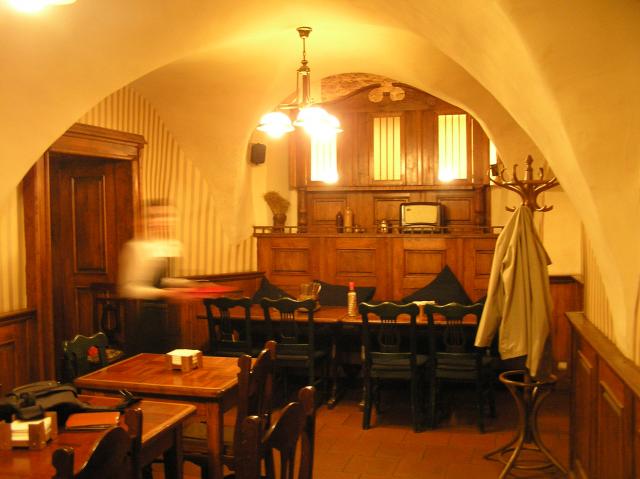
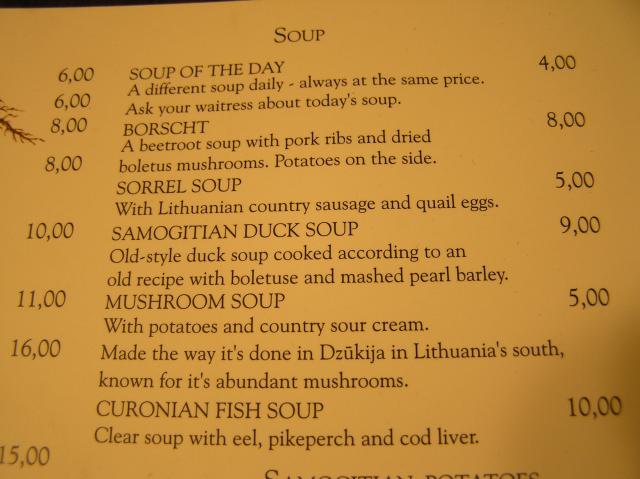
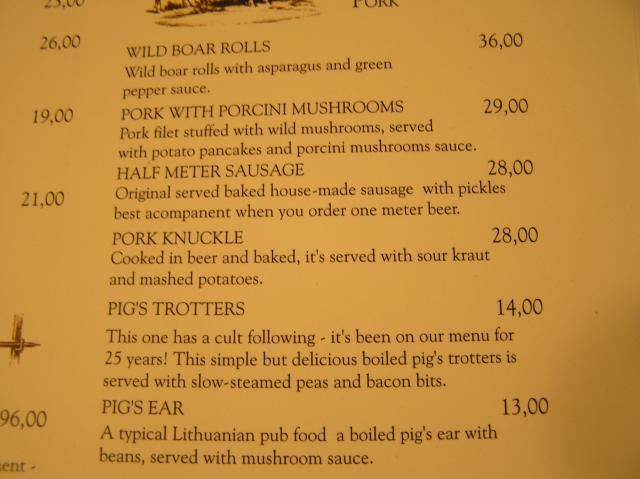
I decided on beer snacks and pigs ear. Seemed like a good idea and sounded like pretty authentically pub food.
Beer snacks: fried rye bread, bread sticks, curd cheese and presereved herring. Served with a few cloves of raw garlic. Nice with the beer.
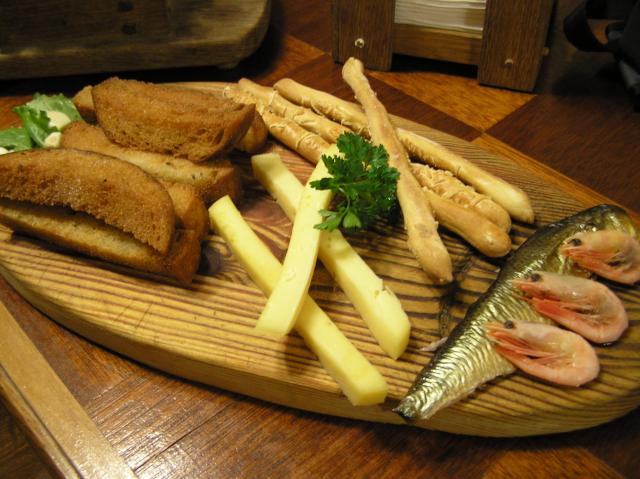 .
.Pigs ear with mushrrom sauce and beans. The only dish that I really didn't like on the trip (and I am fussy), just a little bit too nasty and tasting of Campbell's Cream of Mushroom, which is a disapointment after seeing huge amounts of wild mushrooms at the markets. Still I think that I only have my self to blame.

-
A grave error of judgement. Due to an unwise decision to try several locally popular products at once (curds, rye bread, preserved fish and lietiniai (pancakes), I managed combine banana pancakes and preserved herring on the same plate. Note to self - Do not do this again.
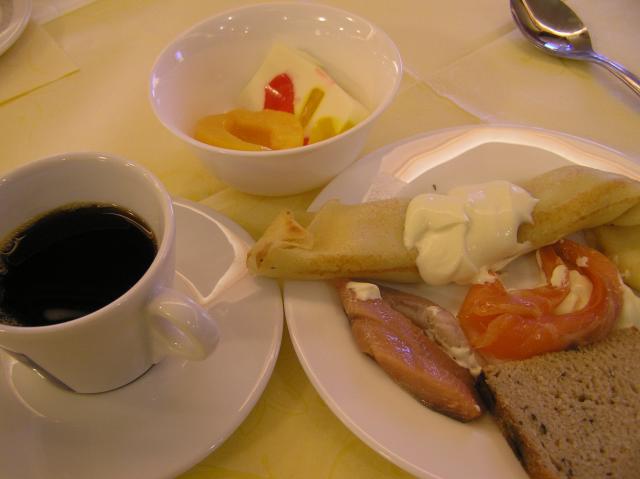
-
I'm loving all these photos! Much of the food is vaguely -- or more than vaguely -- familiar. My mother's mother's parents were from Wilno Gubernya, or Vilna (Vilnius) District in imperial Russia. Of course, the vibrant Jewish community was wiped out by the Nazis and collaborators, but Jewish food in any part of the world is in many instances kosher versions of local non-Jewish cuisine.
Anyway, as a side note, Karaim in Hebrew translates into English as Karaites, unless there's another meaning. I don't think that Karaism has much to do with the Khazars or Turks, but rather is an ancient schism in Judaism. However, this page on the Karaite Korner explains that:
[...]Alongside the Karaite Jews there is a second group who use the name "Karaite" or in their own language "Karaylar" (Zajaczkowski p.11). These Karaylar-Karaites are an ethnic group originating in Eastern Europe although their exact origins are a topic of much debate. It seems they are in part descendants of Karaite Jews, who left Karaite Judaism in the late 19th or early 20th Century. According to the Karaylar-Karaites themselves, they are descended from Tataric-Turkic tribes and they readily back this up with linguistic and anthropological evidence. Karaylar-Karaites are often confused with Karaite Jews and whenever this happens they are quick to point out that they are not Jews at all.[...]If the Karaylar-Karaites left Karaite-Judaism, why did they keep the name "Karaite" or in their language "Karaylar"? The main reason is that the Karaylar-Karaites spoke an ancient Tataric language called "Karaim" and the name "Karaylar" identified them as speakers of this language and bearers of the associated cultural heritage.[...]
So it is these people to whom you are referring. Thanks for inducing me to learn something really interesting I had no knowledge of.
Thanks for that. So much for guide books I guess.

-
Another purchase. These are Sakotis (tree cake). These belong to a medieval tradition of producing a cake infront of an open fire on a spit. They were common in England, France and Germany to my knowledge, so it was a treat to see them here as they are now quite rare.
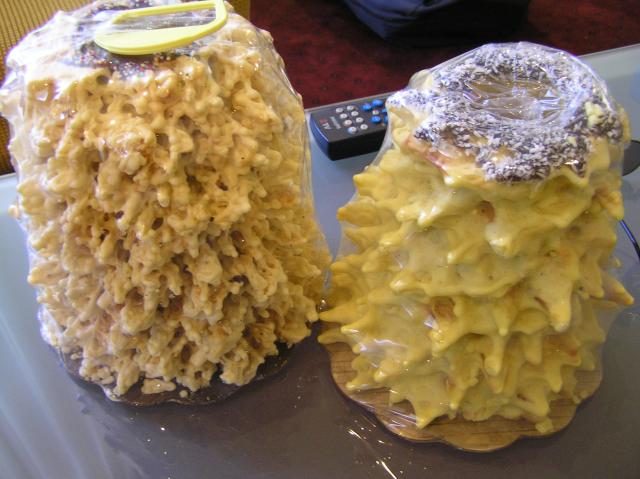 .
. As you can see they are quite popular.
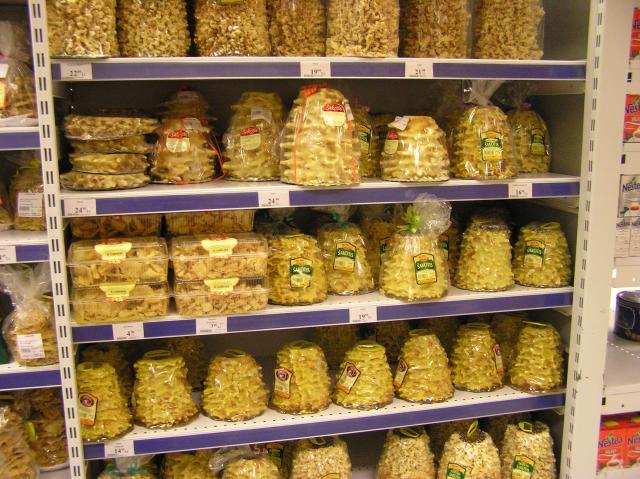
This version is similar to the French Gâteau à la broche, basically a enriched meringue. The German version is more complicated (and tasty) and is part of the requirement for the master of pastry qualification (I believe). As there German version in layered, you get rings in the cut cake, hence Baumkuchen "Tree Bread" in German.
A section of Baumkuchen, made in Edinburgh.
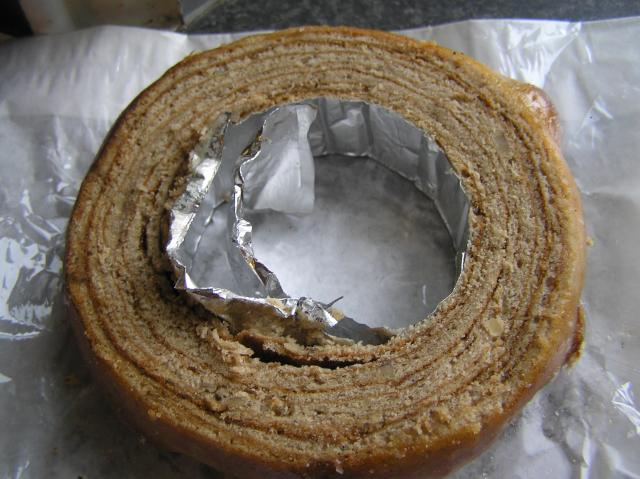
This is very similar to the Dutck Spekkoek, which is no longer made on the spit, but rather layered in a tin and from here this cake went to SE-Asia were it is called Kuih Lapis "Layer Cake".
Anyway I was happy so see another veriosn on this cake.

-
Another cultural activity that had been organised for us was a trip to "Grutas Park", otherwise known as "Stalin World". This is located at the village or Gruto, several hours from Vilnius. After indendence the Baltic states had many Soviet propaganda statues, as most towns/villages had a Lenin some other Soviet hero statue. For the most part these were removed for storage, but in Lithuania a Mushroom, berry an snail tycoon obtained these and set them up in a forest. I though this would be completely naff, but I found experience pretty shocking.
This is Lenin from one of the seaside towns which was a resort for high ranking soviet officials. Therefore he is relaxed and jolly. Most other statues were more stern.
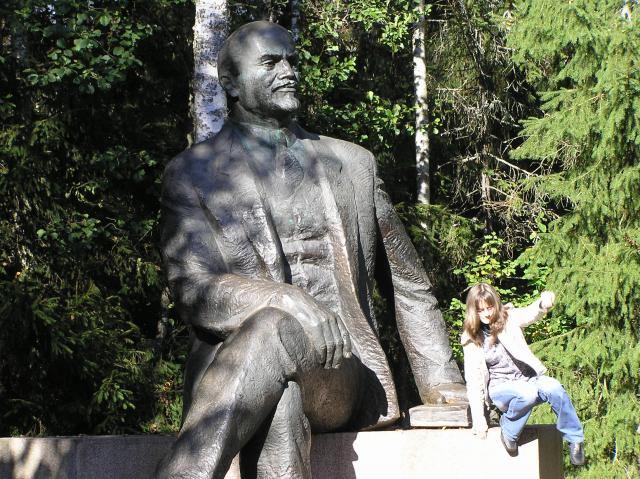
Lunch was provided at the part this consited of koldunai (pork dumplings) in a chicken and dill broth.
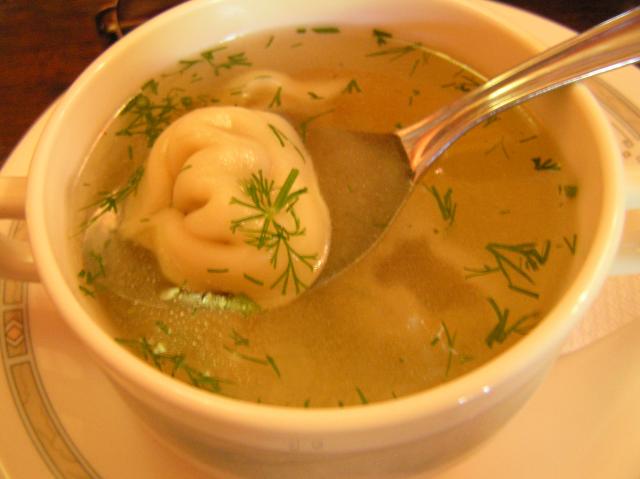
And Dilled Zander with a grilled Bolete and a bolete sauce. Only appropriate when you consider that the park is owned by the local Mushroom King
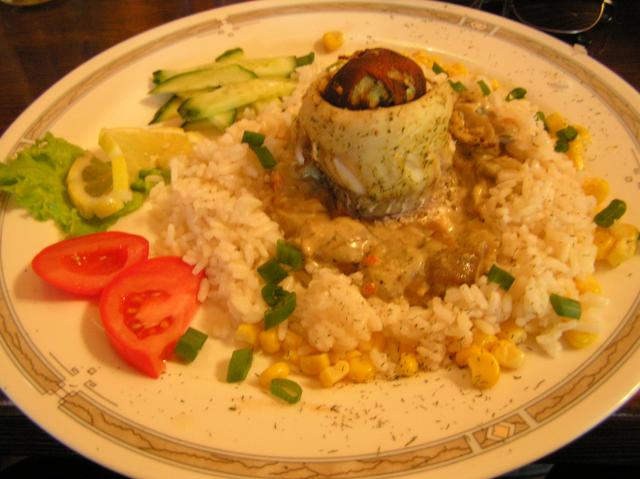
-
A quick meal taken at a tavern. This is Perch-Pike/Zander with an apple and leek sauce (a fortified hollandaise I think). This was the most common fish on Vilnius menus. I have always wnated to eat this fish as frieds tell me that it is one of the most tasty fresh water fish in Europe. They are correct. This particular fish had been rolled/marinated in dill and fried, very sweet and not a bit muddy. Dill was extremely common in Vilnius, you could smell it walking down the street in the evening.
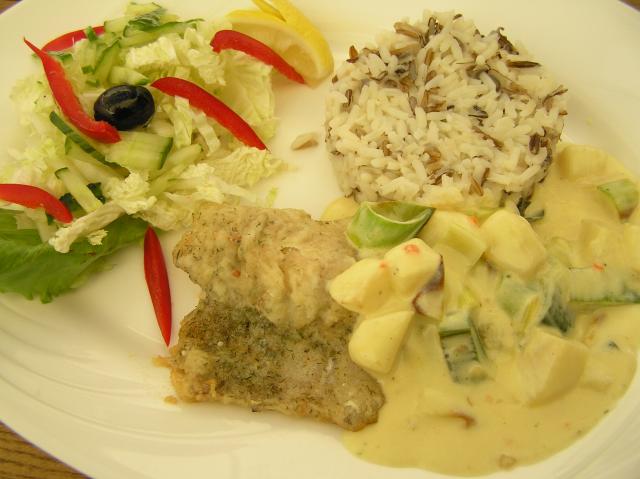
-
damn it Adam, you should have told me you go there - after all i consider myself the expert in all things Vilnius and Lithuanian

Excellent, so do you know what type of flower/plant/tree "gukuai" refers to (honey type) and what type of mushroom is called "Grybai"?
Blast, just found ou that "Grybai" means "Mushroom". Bugger.
-
One interesting meal I had was at "Lokus". Upstairs is an up market steak house, below is ground is a semi-Medieval themed Bistro. To get downstairs you have to squeeze down a several levels of a very twisty, tight staircase. I am 6 ft, any taller or fatter and it would have been Winney the Pooh time.
A nice barrel vaulted basement room, with waitresses in tasteful medieval garb and a couple of chaps wearin tights playing "Stairway to Heaven" on Lute and recorder. Surreal, but somehow cool against all odds.

The menu was very game orientated with quite long descriptions on how people ate in the medieval period. Some dishes were hands only.
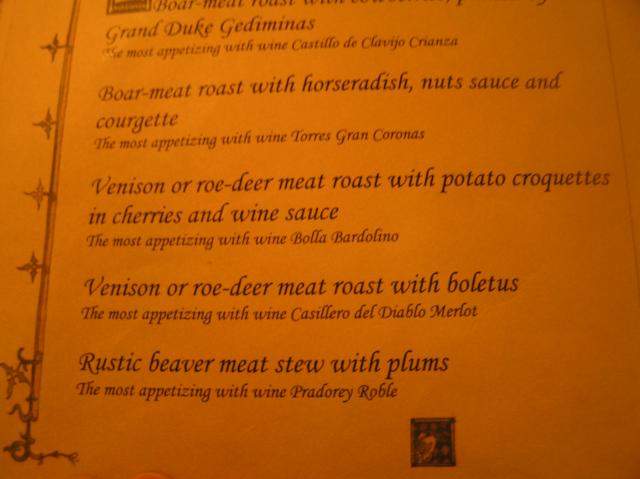
Obviously I had to have the beaver.
But, the starter was Bolete (Porcini), which contianed huge amounts of the mushroom, with sour cream.
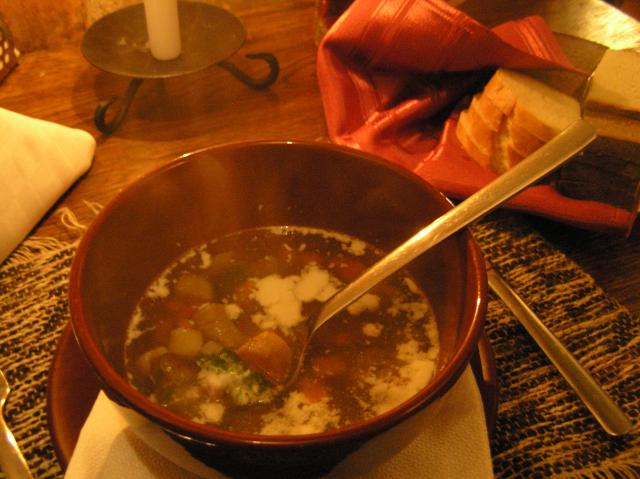
The beaver stew was spices and sharpend with vinegar and sweetened with dried plums. This combination struck me as resembling some Jewish dishes, but I have also seen similar 14th century Christian dishes and also a class of Medieval Muslim dishes cooked in the same manner, so who knows. I think the beaver cut was the tail, as the chunks of meat had a certain gelatinous quality. Tasted similar to lamb and rabbit if you can imagine this. Mildly gamey. Drank this with some of the local dark beer which is excellent.
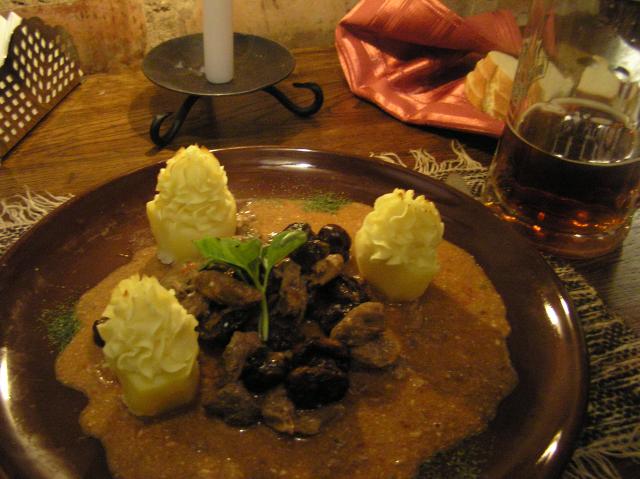
Dessert was Saltanosiai ("blue noses"). Bilberry dumplings with sour cream. Excellent flavours, but the dumplings were a little bit sturdy for me. I drank this with some of the lcoal mead which is fortified and very popular.
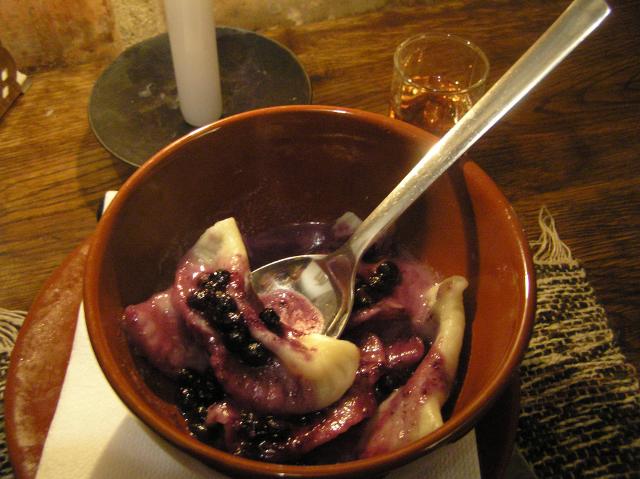
This all cost ~ £12. Bargin.
Another interesting thing was this: Huge amounts of alcohol at cheap prices. The are in a lot of trouble when the Brits work this out.
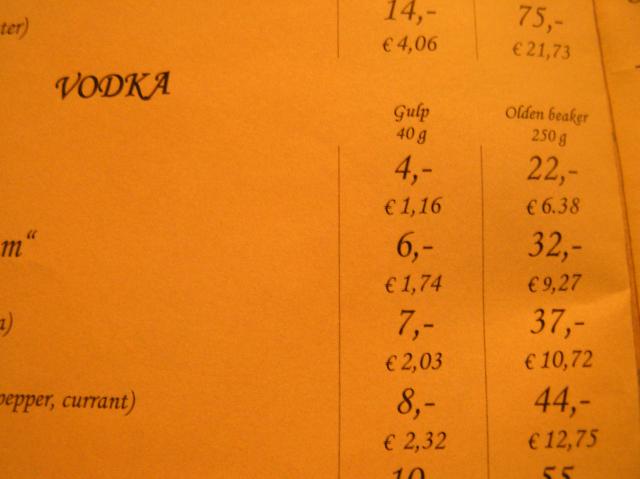
-
Another extremely popular dish in Vilnius are Didzkukuliai, potato dumplings, know commonly as "Zeppelins" (translated into English). These are amde by mixing raw grated potato with mashed potato, adding a stuffing and boiling in salted water. Common fillings are pork, curd cheese or wild mushrooms. Often they are topped with sour cream or crispy bacon/lard bits. Very nice but extremely sturdy. The Estonians and Latvians I was with considered them to be a Lithuanian barbarism and a clear sign of too much contact with Polish culture.

From a local fast food place.
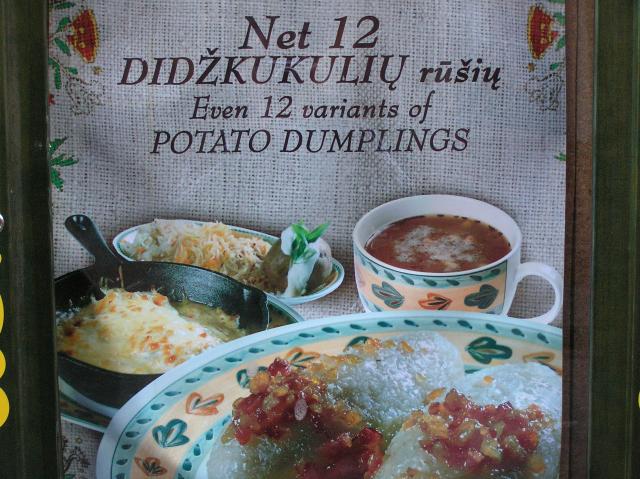
Another fast food chain was "Chile Coffee". Let me tell you that the combination of coffee, chili and Campari is not a successful one. And I like Campari.

-
One item that was very good in Vilnius was the Rye bread. This was the major bread type in the area and came in several grades (different proportions of rye to wheat flour) and several different recipes. All good. It was solid bread, but also moist and sweet, really excellent with the the preserved fish and curd cheeses that were also very common.
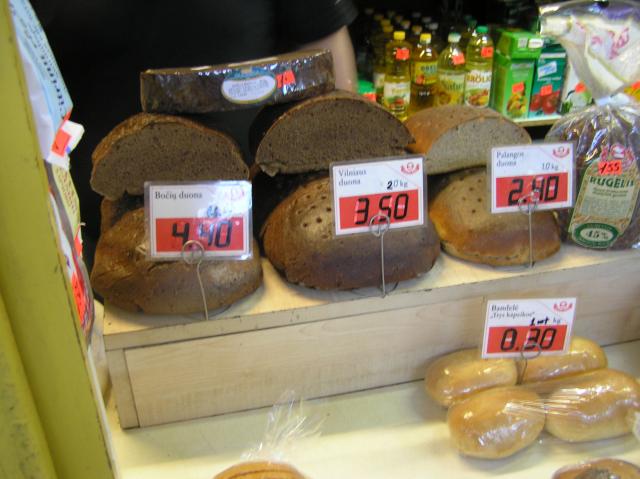
In fact I like the bread so much that I made making this bread at home a goal of the trip. Now from what I was able to gather it is a sour dough (or tradionally it is) and it is made in a special bread troughs carved from a single piece of wood. As these bread troughs are wooden some of the culture gets trapped in the wood grain, this innoculates the new batch of bread. These bread troughs are actually quite commonly on sale, but these tend to be old and scrubbed clean.
While I was visiting the town of Trakai (famous for its restored lake castle and the Karaim, a group of Turkic speaking Khazars that practice a form of Judaism who moved from rom the Crimea to this area in the 14th century), I noticed that amoungst all the tourist stuff on sale on older lady was selling bits a pieces of household goods. I bought this bread trough off her.
You can see that it is old enough to have somw wood worm damage, but it also has some dark stains which are from the rye bread dough. There looks to be a coating of old rye dough, so I attempt to revive this rye dough culture. I will report on how this workd out.
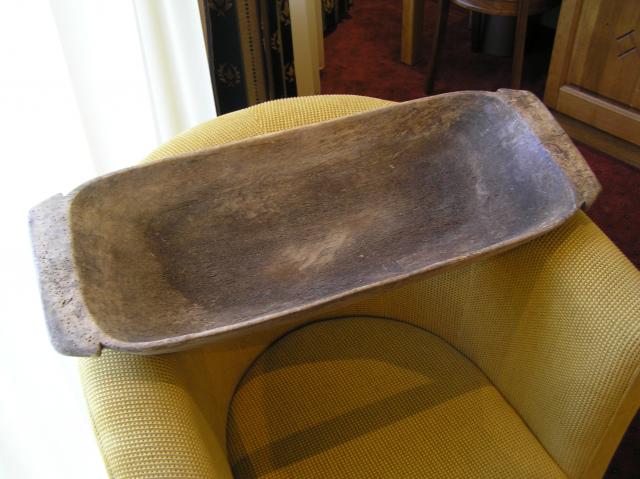
The lady was also able to tell me that other dough products are made in these troughs, including dumplings and something she called "Macaroons". I am not sure if this is the local word or she was saying that it was like Italian macaroni as she demonstrated rubbing dry dough in the trough until small pellets are formed, a bit like couscous really.
Trakai Castle

-
One non-food thing I will mention is the importance that Flowers seems to have in Vilnius. This ranged from old women selling scrappy bunches of daisys, to quite expensive florists. I liked this bunch of flowers been sold on the street corner, due to its strong similarity to a certain well known painting.

-
Nobody is suggesting that the Persians taught the Chinese to make noodles as after all the Chinese invented everything...
Certainly it appears that the root word for some types of pasta are Persian, I don't think that this is in doubt. An interesting question is where the Chinese got there soft-wheat from as the origin of this is in the middle-east, not the far east.
My Italian friends* insist that pasta originated in Italy.Isn't Persian Lakhsha is just a riff off La(g)sagna?
Seriously though, does evidence exist to support the theory that the Chinese learnt noodle-making from the Persians? I think all "Laksa" tells is that that the Persians (or Arabs) introduced that word, along with a host of others, to the Malay language.
*They are those guys you see wearing "Italians do it better" t-shirts.
-
There was a back room for the fish.
This was divided into saltwater fish which were either brined or smoked.
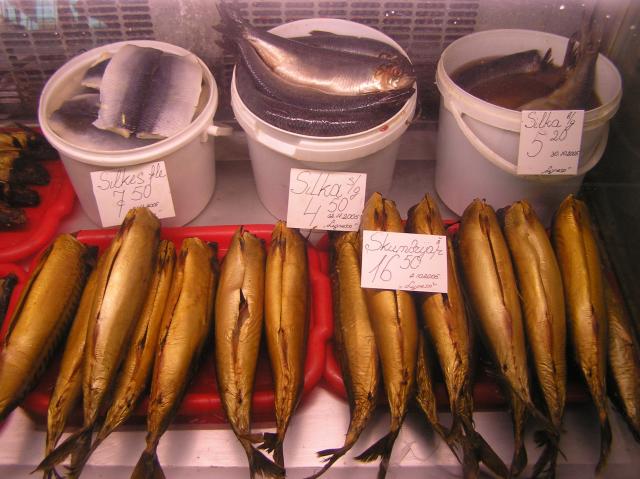
And sweetwater fish which were fresh.
Zander (Walleye in the USA)
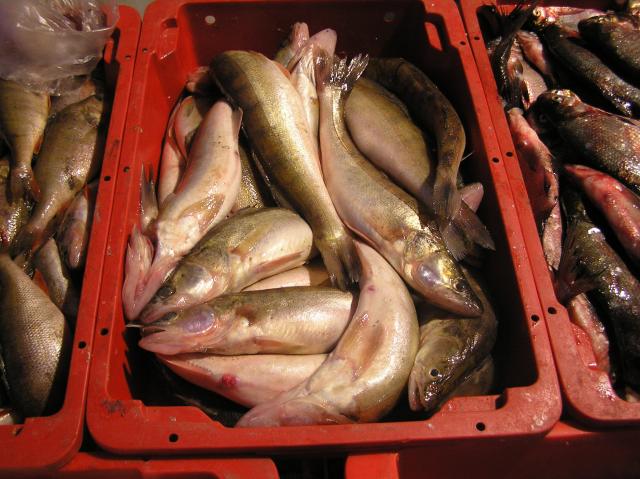
Perch
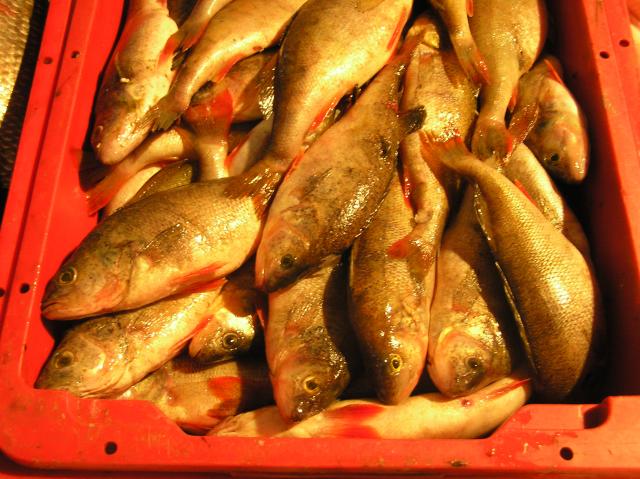
Salmon-Trout
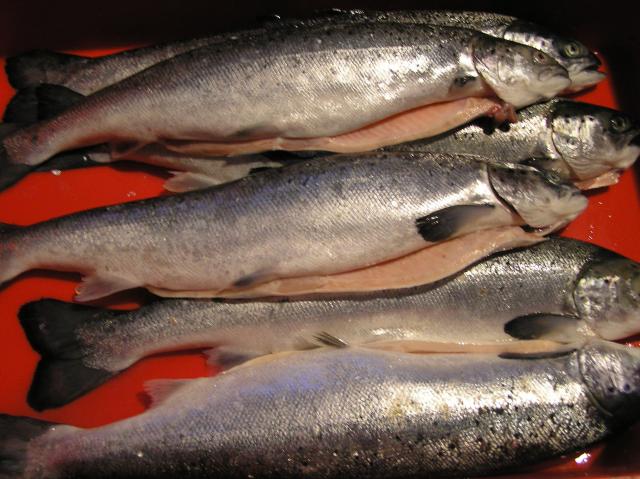
I think these are Bream
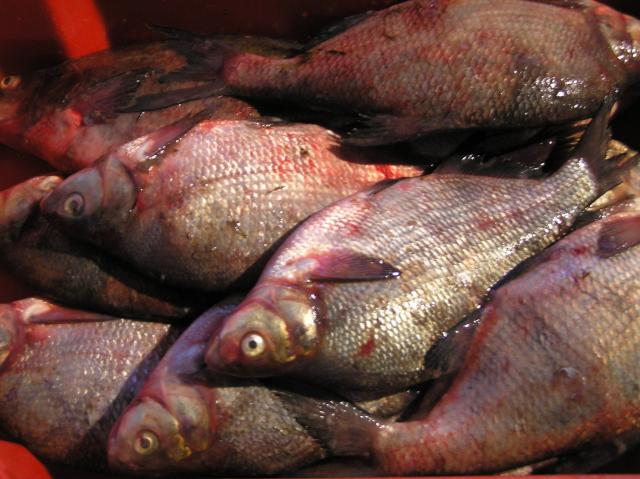
Of these the Zander was the most common fish in restaurant menus.
Right more tomorrow, where I describe blow for blow eating beaver for the first time.
-
Few fresh fruit and veg at this market, but the ones that were there did answer a long standing question for me "Are flowering quince Chaenomeles speciosa edible?". Yes they are.

-
Apart from the hugh amount of meat, there was also a few stalls selling berries, honey and mushrooms. The ladies at these stalls were very nice and I must have tasted half a kilo of honey. One (gukuai?) was extremely delicous, a very complex flavour and the the ladies said it would make me strong like a Lithuanian man and give me lots of children. I bought a small jar. The same stall sold bunchs of herbs, seeds and dried mushrooms called grybai. No idea what these are, some type of bolete by the look of them. I hope they don't kill me.

Pickled veg. are obviously very popular.
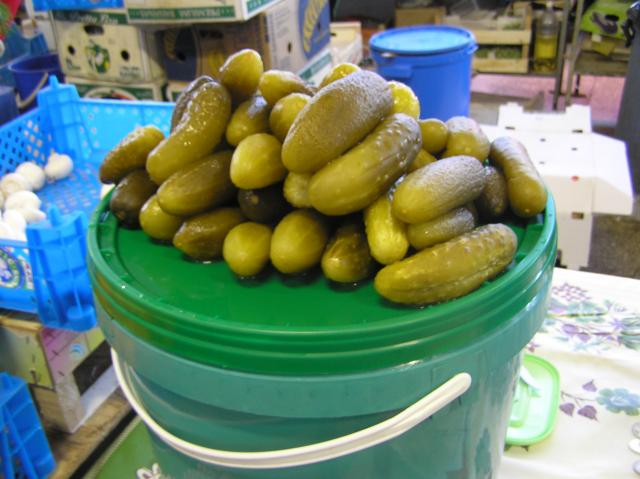

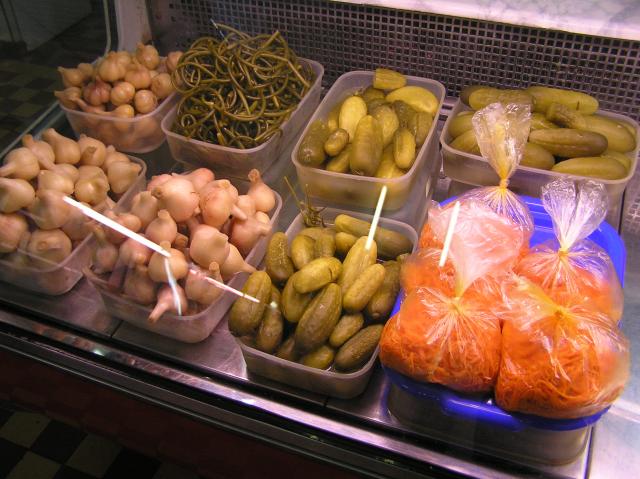
-
Lard is obviously the cooking fat of choice in the region. A hugh percentage of the market is dedicated to selling preserved lard. The strange thing is that I can recognise different grades of lard, I can't work out why there need to be 20 stalls plus selling mountains of the stuff. How much can a house hold go through in a week?
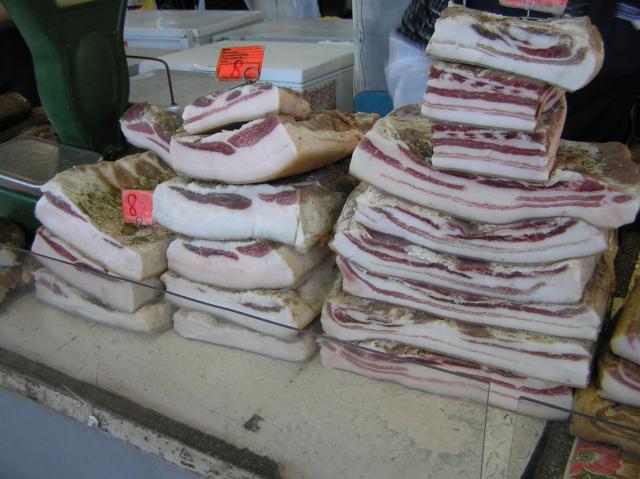
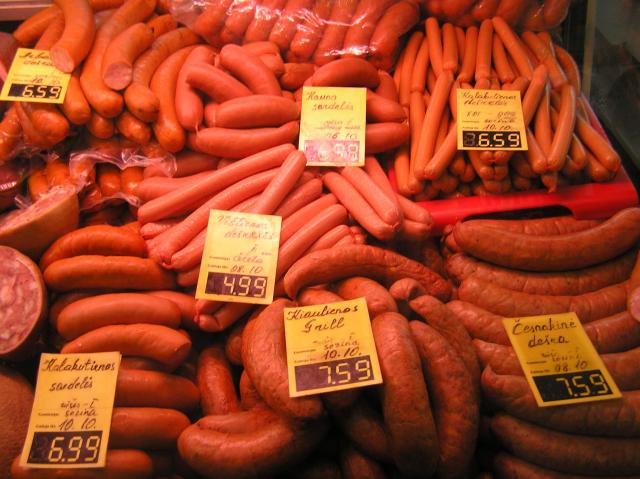


Lithuanian Haggis!

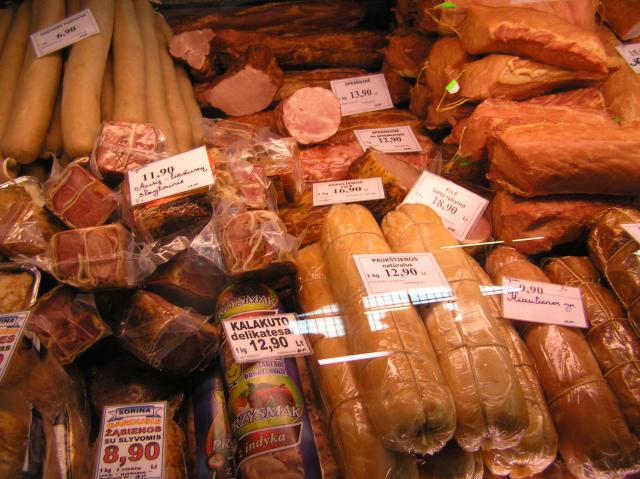

I quite liked this. This is a meat sausage, stuffed in some type of body organ. After smoking the veins/lymph vessels stand out quite distinctly, so obviously when plastic wrappers replaced the natural casing, the design still incorporates the patterns of the veins.
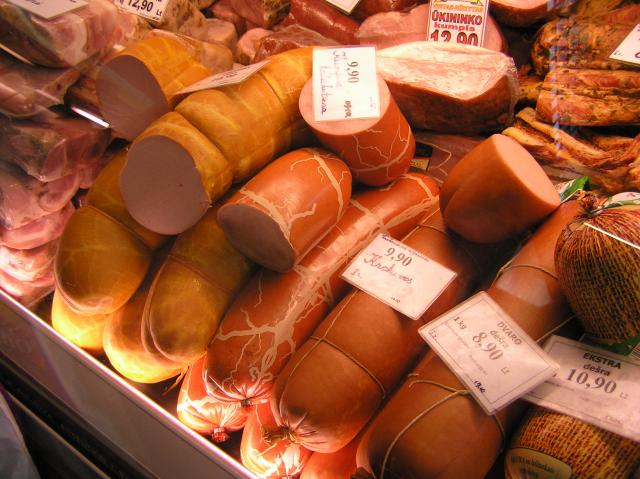
-
The southern market is entirely enclosed, except for a few stalls were people sell berries, flowers and mushrooms (not really part of the market proper), it is very much a temple of Pork. The is pork the likes of which I have never seen. Forget modern Western breeding for the lean pig, these porkers had at least three inches of back fat.

These huge pigs were sectioned by even larger men with very, very big axes that looked like props from 'The Lord of The Rings'
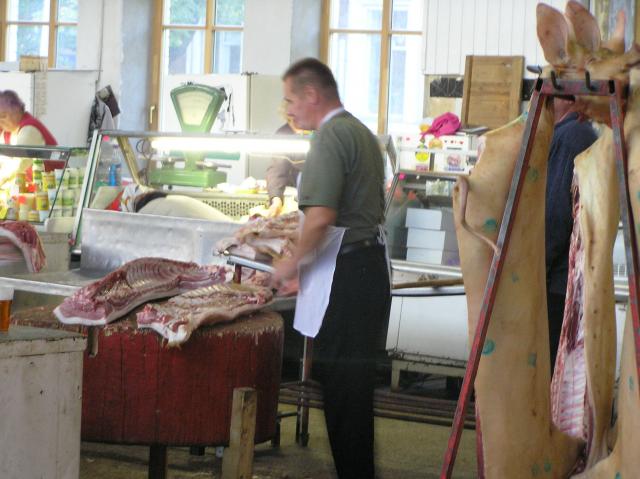
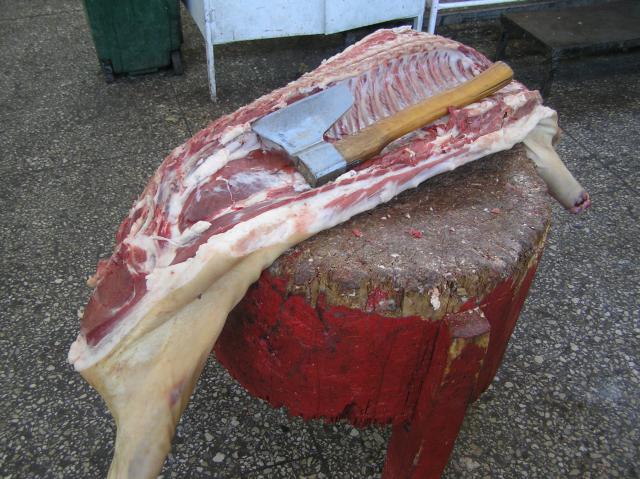
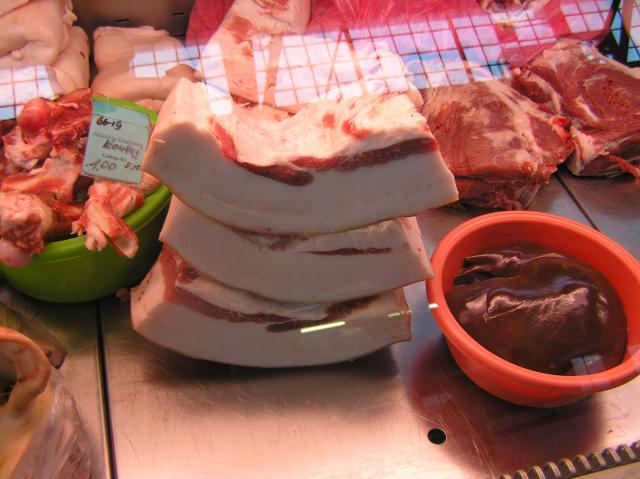



the pasta debate
in Food Traditions & Culture
Posted
I see, thanks for the information I will look forward to reading the article.
Golly, just imagine that 4,000 years ago when the present day Brits ancestors were chomping on boiled lumps of stodge, the Chinese were making noodles. Amazing how times have changed.